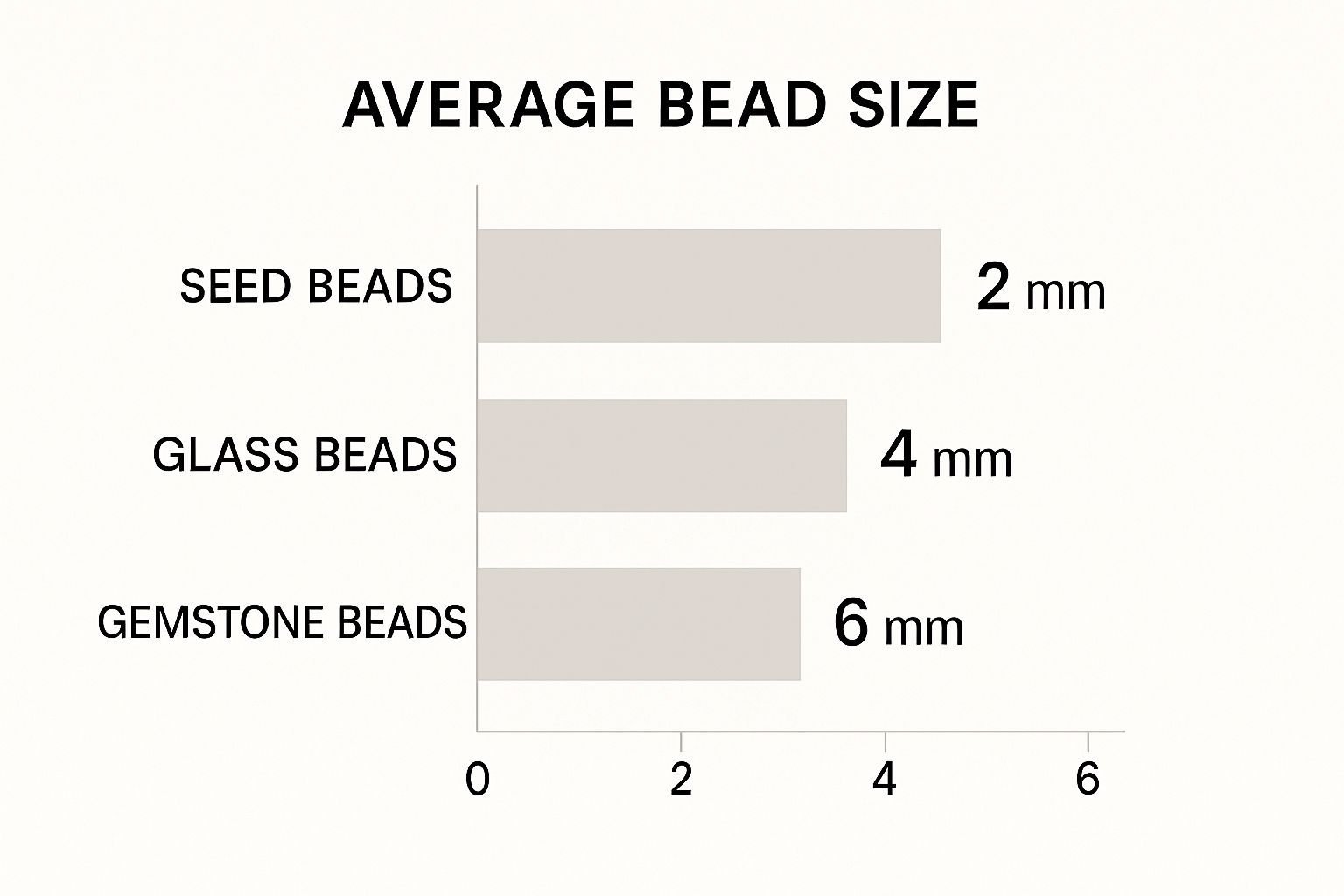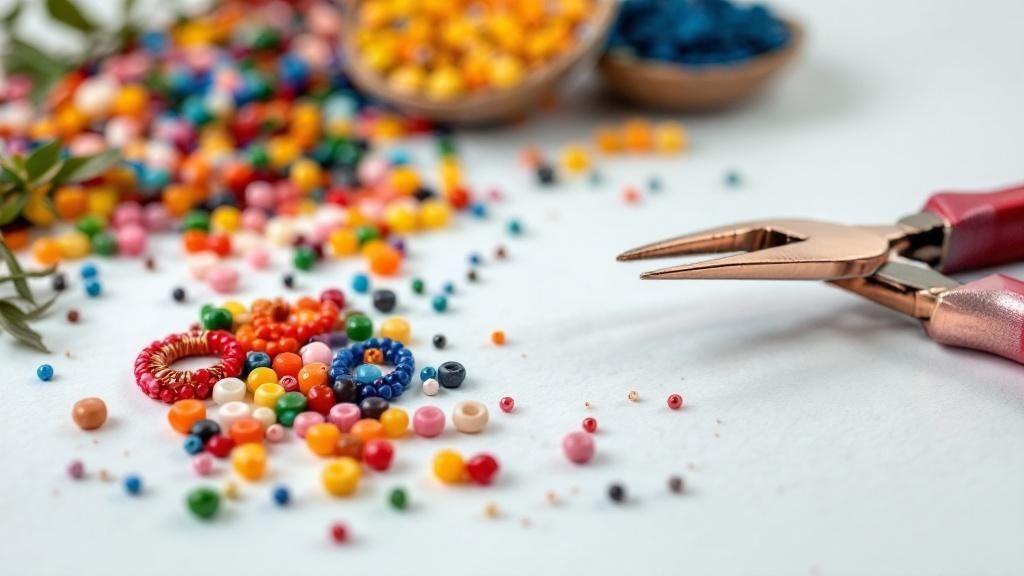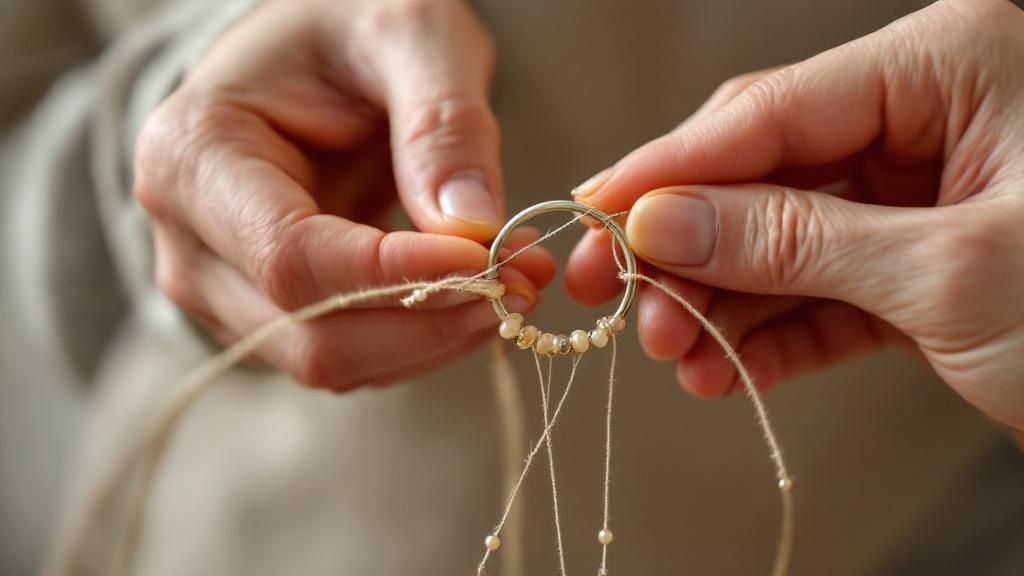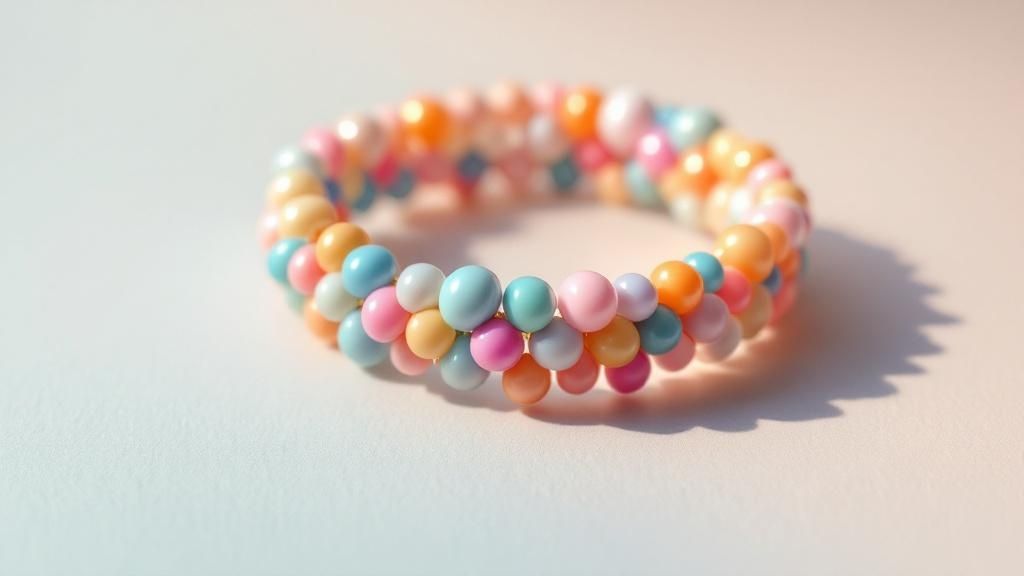Learn How to Make Beaded Rings: Easy Step-by-Step Guide
- seanmawhinney
- Jun 7
- 12 min read
Getting Your Materials Right (Without Breaking The Bank)

This infographic offers a quick look at average bead sizes, comparing seed beads (2mm), glass beads (4mm), and gemstone beads (6mm). The size you choose significantly affects your ring's design and how it fits. Picking the right size is key for both the look and comfort of your finished piece.
Beads: The Heart of Your Ring
Beads are naturally the most important element when you’re learning to make beaded rings. Explore different materials to discover what you like working with. Glass beads are durable and come in a wide range of colors. Natural stones give your rings an earthy, organic look. For detailed designs, small seed beads provide countless options. Remember that quality matters. Using consistently sized beads with smooth holes ensures a professional-looking ring.
Wire: Strength and Flexibility
The wire forms the structure of your ring. Wire gauge, or thickness, determines how strong and flexible the wire is. Thicker gauges (represented by smaller numbers) are durable and best for bolder designs. Thinner gauges (larger numbers) allow for intricate work and delicate rings, but may break more easily.
Thread: The Unsung Hero
Strong thread is essential. Weak thread can break while you’re working, wasting your time and materials. Nylon or silk threads offer good durability and can handle the tension of beading. A sturdy thread like waxed nylon, for example, will give your rings lasting strength.
Tools: Investing Wisely
The right tools simplify the ring-making process. Jewelry pliers, particularly those with smooth jaws, are essential for working with jump rings without damaging them. You don't need every specialized tool right away. Start with a basic toolkit and add more as your designs become more complex. Don’t forget storage!
Storage and Organization: A Crafter's Best Friend
An organized workspace is a must for any craft. A dedicated area for your tools and materials saves you time and prevents frustration. Storing your beads in labeled containers and keeping wire neatly coiled will protect your supplies and keep them in good condition. This lets you focus on your creativity and enjoy the process of making your rings.
To understand the growing popularity of beading, take a look at the global bead products market. In 2024, this market was valued at USD 18.2 billion. It's projected to reach USD 35.4 billion by 2033, with a CAGR of 7.27%. This growth reflects the rising demand for beads across different crafts, especially jewelry making. You can find more statistics here: Learn more about the bead market.
To help you choose the right bead material for your ring projects, we’ve put together a helpful comparison table.
Bead Types and Material Comparison A comprehensive comparison of different bead materials, their durability, cost, and best use cases for ring making
Bead Material | Durability Rating | Price Range | Best For | Care Requirements |
|---|---|---|---|---|
Glass Beads | High | Low to Moderate | Colorful rings, everyday wear | Minimal, avoid harsh chemicals |
Seed Beads | Moderate | Low | Intricate designs, small details | Handle with care, avoid crushing |
Gemstone Beads | High | Moderate to High | Statement rings, special occasions | Depends on the stone, may require gentle cleaning |
Metal Beads | High | Moderate to High | Modern designs, mixed-media projects | Avoid scratches, polish as needed |
Polymer Clay Beads | Moderate | Low to Moderate | Unique, handcrafted looks | Protect from moisture and extreme temperatures |
This table provides a general overview, and the specific properties of each material can vary. With a bit of research and planning, you can select the perfect beads for your next ring creation. Now that we've covered the materials, let's move on to the step-by-step guide for crafting your own beaded rings.
Nailing The Perfect Fit Every Single Time

Ensuring a proper fit for your beaded rings is essential. A beautifully crafted ring loses its appeal if it's uncomfortable to wear. This highlights the inadequacy of the "string around the finger" method, often inaccurate due to the string's elasticity and inconsistent tension. For precise measurements, consider the techniques employed by professional jewelers.
Accurate Measurement Techniques
Accurate ring sizing relies on specialized tools like a ring sizer, a set of graduated metal rings, or a mandrel, a tapered rod with size markings. These tools offer far greater precision. Remember, finger size fluctuates throughout the day, typically larger in the evening and after exercise. Factor this into your measurements.
Bead Size Considerations
Bead size plays a significant role in the final ring size. Larger beads increase the overall circumference. For instance, a ring made with 6mm beads will have a larger circumference than one made with 2mm seed beads. Careful planning and precise measurements are vital when selecting bead sizes, as even a small discrepancy can significantly impact the final fit.
Adjustable Ring Designs and Comfort Testing
Designing adjustable rings offers flexibility, accommodating size changes. This can be achieved using elastic thread or incorporating adjustable loops. Regular comfort checks during the creation process are also essential. This proactive approach ensures a comfortable fit from the outset, preventing rings that are too tight or too loose.
Common Sizing Mistakes and Solutions
Sizing mistakes happen, even to experienced crafters. Overlooking the added circumference from beads when calculating wire or thread length is a common error. Another is forgetting how the tension of the stringing material affects the final size. Fortunately, there are ways to rectify rings that turn out too tight or too loose. Resources like How to resize a ring at home offer practical solutions. Understanding these common pitfalls and their remedies helps ensure perfectly fitting beaded rings every time. A well-fitting ring enhances both appearance and comfort.
Mastering The Techniques That Actually Work

Creating intricate beaded rings goes beyond simply stringing beads together. It involves developing key skills and understanding core techniques that unlock a world of design possibilities. Mastering fundamentals like tension and spacing is paramount for achieving professional-looking and durable pieces.
Achieving Consistent Tension and Spacing
Consistent tension is essential. It prevents your rings from being too loose or too tight, ensuring the beads lie comfortably and securely. Maintaining even spacing also plays a vital role. It distributes the beads uniformly, avoiding any unattractive gaps or bunching that can detract from the overall design. Imagine stringing beads on elastic cord: inconsistent tension creates an uneven, unprofessional appearance. Consistent tension and spacing, however, showcase your attention to detail and skill.
Weaving Patterns: Peyote and Brick Stitch
Beyond basic stringing, weaving techniques add another layer of intricacy and visual interest to your beaded rings. Peyote stitch, a popular choice, creates a distinctive textured, almost woven look. Brick stitch, alternatively, provides a more geometric and structured appearance, resembling a brick wall. Mastering these techniques opens up a vast array of design options. For inspiration on incorporating different gemstones into your designs, check out Top 10 Best Gemstones for Jewelry in 2025.
Troubleshooting Common Problems
As with any craft, encountering challenges is inevitable. Learning to identify and address common problems early on can save you time and frustration. Loose connections are a frequent issue that can cause your rings to fall apart. Similarly, thread tangling can lead to uneven tension and wasted materials. By recognizing and rectifying these problems promptly, you can ensure the success of your ring-making endeavors.
Professional Finishing Techniques
The final touches can truly elevate your handmade beaded rings from amateur to professional. Closure techniques are crucial. They significantly impact a ring's durability and overall aesthetic. Properly executed closures contribute to both the longevity and the polished look of your piece. Invisible joins, for example, demonstrate meticulous craftsmanship and create a seamless, sophisticated finish.
Choosing the Right Closure Technique
Selecting the appropriate closure technique depends on the specific design and materials used. A delicate ring crafted with small seed beads might benefit from a subtle, almost invisible clasp. A bolder design, however, could incorporate a decorative clasp as a prominent design element. Choosing the right closure considers factors such as the materials used, the size of the beads, and the overall style you aim to achieve. Mastering these techniques ensures your beaded rings are not only beautiful but also robust enough for everyday wear.
Creating Rings That Match Your Personal Style

Now that you've learned the basics of beaded ring making, it's time to get creative. Take those foundational skills and turn them into rings that truly reflect your individual style. Whether you prefer minimalist elegance or bold, eye-catching pieces, the possibilities are vast.
Exploring Different Ring Styles
Beaded rings offer a surprising range of design options. A simple, single-band ring, for example, is ideal for everyday wear and can be incredibly stylish. Alternatively, a statement piece with larger beads or complex patterns can become a conversation starter. And don't forget about stackable ring sets, which offer versatility and allow you to mix and match for different looks. Each style has its own appeal, and mastering the techniques for each opens up a world of design potential.
Combining Bead Sizes, Shapes, and Textures
Creating visually interesting rings often involves experimenting with different bead characteristics. Using a variety of bead sizes, shapes, and textures adds depth and intrigue to your pieces. Think about a ring featuring smooth, round beads alongside faceted, geometric ones. This creates a captivating interplay of light and shadow.
However, it's important to find a balance. Too much variation can make a design feel cluttered. This also applies to textures. Combining smooth and textured beads can result in a piece that is both visually and tactilely interesting.
Color Theory Principles for Eye-Catching Rings
Color is a crucial element in jewelry design. A basic understanding of color theory can help you make smart choices that elevate your beaded rings. Complementary colors, located opposite each other on the color wheel, create strong contrast. Analogous colors, which sit next to each other, offer a more harmonious look.
Consider how the bead colors work with the wearer's skin tone and clothing. Warm colors tend to complement warmer skin tones, while cooler colors work well with cooler undertones.
Inspiration and Adapting Trends
Inspiration for ring designs can come from many places. Themed designs, like nature-inspired rings with leaf-shaped beads or holiday-themed rings featuring festive colors, are a great starting point. Adding personal touches, such as meaningful charms or birthstones, brings sentimental value.
Fashion trends also offer a wealth of inspiration. Incorporating trending colors or patterns can keep your designs current. By continually exploring and experimenting, you’ll develop your own signature style. The key is to blend trends with your personal vision, creating rings that are both fashionable and uniquely you.
Advanced Skills And Problem-Solving Like A Pro
This section takes your ring-making to the next level. We'll explore advanced techniques and essential problem-solving strategies, moving beyond basic stringing to incorporate complex weaving patterns, wire-wrapping, and mixed-media elements.
Integrating Wire-Wrapping and Mixed-Media Approaches
Wire-wrapping is the art of using wire to secure and embellish beads. It adds another dimension of artistry and complexity to ring designs. A simple beaded band, for example, can be significantly enhanced with wire-wrapped embellishments, opening up a whole new world of design possibilities.
Furthermore, combining beads with metal components creates sophisticated mixed-media pieces. Imagine beaded rings accented with silver or copper. The interplay of textures and colors makes for truly unique and eye-catching jewelry.
Mastering Tension, Stress Points, and Invisible Joins
Consistent tension is crucial for a ring's durability and professional look. Think of it like a suspension bridge: evenly distributed tension ensures structural integrity. Reinforcing stress points—where the beads join, where the wire connects, or areas prone to wear—is equally important. This reinforcement prevents breakage and strengthens the overall piece.
Invisible joins are a hallmark of expert craftsmanship. These seamless connections create a smooth, uninterrupted flow between beads and other components. Mastering this technique elevates your work, distinguishing it from amateur efforts.
Advanced Troubleshooting and Repair Techniques
Challenges are inevitable in any creative process. Thread breakage can be especially frustrating mid-project, particularly when working with intricate weaving patterns. Knowing how to repair a broken thread without unraveling the entire piece is a valuable skill, saving both time and materials.
Encountering a cracked bead doesn't necessarily mean starting over. Learning how to repair such damage, rather than discarding the entire piece, is a crucial skill. Sometimes, a finished ring might require resizing. Understanding techniques for adding or removing beads without compromising the overall design can be incredibly useful.
However, there are times when starting anew is more efficient than attempting repairs. Recognizing this critical point is a mark of experience. By mastering these advanced skills and troubleshooting techniques, you'll move beyond simply creating beaded rings. You’ll craft high-quality, durable pieces that reflect true artistry.
Why Handmade Beaded Rings Are Having A Major Moment
The fashion world is constantly changing, and currently, handmade beaded rings are experiencing a surge in popularity. This isn't just a passing fad; it signifies a larger cultural movement towards personalized accessories and mindful consumption. Consumers are increasingly looking for unique items that reflect their individual style, moving away from mass-produced jewelry.
This desire for self-expression is a key driver behind the growing demand for handcrafted beaded rings.
The Rise of Artisanal Jewelry and Personal Expression
This shift is fueled by a growing appreciation for artisanal craftsmanship and the desire to own something truly special. Mass-produced jewelry often lacks the personal touch and unique story that handmade pieces offer. A beaded ring crafted with specific gemstones chosen for their individual meaning, for instance, becomes more than just an accessory; it transforms into a personal statement. This resonates deeply with consumers seeking individuality and authenticity in their style.
Sustainability and the Conscious Consumer
The increasing emphasis on sustainability within the fashion industry also contributes to the popularity of handmade beaded rings. Today's consumers are more aware of the environmental and social impact of their buying choices. Handmade jewelry, often made with ethically sourced materials and produced in smaller batches, aligns perfectly with these values. This conscious approach to consumption further boosts the demand for handmade accessories like beaded rings. The global beaded jewelry market, including beaded rings, was valued between USD 5.5 billion and USD 6.04 billion in 2023, highlighting the growing demand for personalized, handcrafted items. For more detailed market statistics, you can Explore the Beaded Jewelry Market.
The Therapeutic Benefits of Crafting
Beyond their aesthetic appeal, creating beaded rings offers significant therapeutic benefits. Many find the process of beading to be a relaxing and meditative activity. The concentration required to string tiny beads and create intricate patterns can be a form of mindfulness, promoting a sense of calm and creative flow. This therapeutic aspect adds another layer of value to handmade beaded rings.
Community and Connection Through Crafting
The craft of jewelry making has also fostered vibrant online and offline communities. Online forums, social media groups, and local workshops offer spaces for connection, inspiration, and the sharing of skills and techniques. Platforms like Instagram and Pinterest serve as virtual galleries, showcasing handcrafted jewelry and connecting artisans with appreciative audiences. These communities provide valuable support and encouragement for those passionate about making beaded rings, allowing them to share designs, techniques, and the joy of creation. This sense of community elevates jewelry making beyond a mere hobby, transforming it into a shared passion that further strengthens the enduring popularity of handcrafted pieces.
Making Eco-Conscious Choices In Your Ring Making
Creating beautiful beaded rings doesn't have to come at the expense of the planet. By making mindful material choices and adopting sustainable practices, you can create stunning jewelry while minimizing your environmental impact. This means considering everything from the source of your beads to the disposal of your crafting materials.
Sustainable Bead Options: Beauty With a Conscience
Exploring sustainable bead options opens up a world of creative possibilities. Recycled glass beads, for example, offer vibrant sparkle while reducing waste. Reclaimed wood beads add a unique, rustic touch, each bead telling a story with its individual grain. Ethically sourced natural stones can also elevate your designs, bringing natural beauty and deeper meaning to your pieces.
Look for suppliers who prioritize fair labor practices and environmental responsibility. This ensures that your creations support ethical production from start to finish. Choosing sustainable beads isn't just about lessening environmental impact; it's about creating jewelry with a conscience. This resonates with the growing number of consumers seeking eco-friendly products.
Threading Materials and Tools: Minimizing Impact
The thread and tools you use also play a role in your ring's environmental footprint. Opt for natural, biodegradable threads like hemp or organic cotton whenever possible. These materials break down naturally, reducing the amount of waste sent to landfills. When choosing tools, prioritize durability and longevity. Well-made tools last longer, reducing the need for frequent replacements and ultimately minimizing waste. By considering these elements, you can minimize your overall impact.
Repurposing and Proper Disposal: Closing the Loop
Sustainability extends beyond the initial creation of your rings. Repurposing damaged jewelry into new designs breathes new life into old materials. This could involve using beads from a broken necklace or repurposing wire from a damaged ring. Proper disposal is also essential. Recycle materials like wire scraps or excess beads whenever possible, and compost biodegradable materials such as natural threads. Adopting these practices creates a more sustainable crafting cycle.
Beaded rings benefit from the growing trend of sustainable fashion. Consumers are actively looking for accessories crafted from recycled or natural materials. This increased demand, amplified by social media, gives artisans and small-scale jewelry makers more visibility. Learn more about the beaded jewelry market.
The Appeal of Sustainable Practices: Aligning With Values
Creating eco-conscious jewelry aligns with the broader movement toward ethical consumption. Many shoppers now prioritize sustainability and ethical sourcing when making purchases. This means your eco-friendly practices can enhance the appeal of your beaded rings, particularly for environmentally conscious buyers. By embracing sustainable ring making, you're not just crafting beautiful jewelry; you're contributing to a more sustainable future.
To understand the differences between sustainable and traditional materials, let's look at the following table:
Sustainable vs Traditional Materials Impact
Comparison of environmental impact, durability, and cost between sustainable and traditional beading materials
Material Type | Environmental Impact | Durability | Cost Difference | Availability |
|---|---|---|---|---|
Recycled Glass | Lower | High | Comparable | Increasing |
Reclaimed Wood | Lower | Moderate | Comparable | Increasing |
Ethically Sourced Stones | Lower | High | Varies | Increasing |
Conventional Glass | Higher | High | Lower | Widely Available |
Untracked Wood | Higher | Varies | Lower | Widely Available |
Unethically Sourced Stones | Higher | High | Lower | Widely Available |
This table highlights the benefits of using sustainable materials. While the cost or availability might vary compared to traditional options, the positive environmental impact and the unique character they bring to your jewelry often make them a preferable choice.
Ready to create your own sustainable beaded rings? Visit the Panther De Luxe Shop for inspiration, tools, and a wide selection of beautiful beads.

Comments